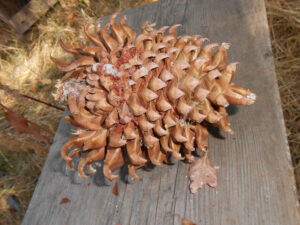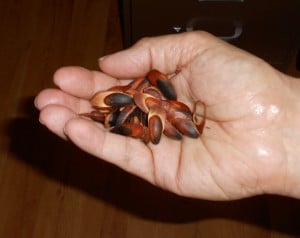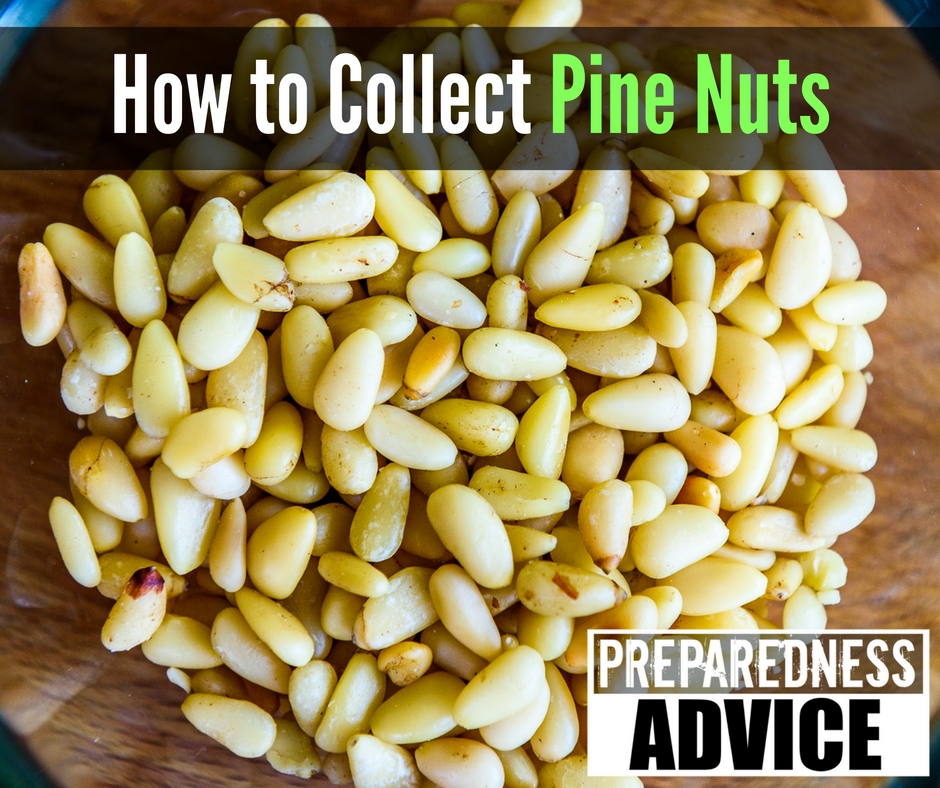Delicious and good for you

The other day while out looking for edible plants, I came across some cones from the digger pines, also sometimes called gray pines. These cones were still intact and had not dropped their seeds, often called pine nuts.
I spent a bit of time and opened one. The digger pines have one of the harder cones and you will need a hammer or a big rock to open them. However, it is worth it you can get a good handful of nuts from one cone.
The individual seeds or nuts then need to be removed from their shell. This is a bit of work and a good pair of pliers will be a big help. If you don’t have the right kind of pliers, I used a Gerber Multi-tool I had with me and this worked just fine. Unshelled pine nuts have a long shelf life if kept dry and refrigerated. Shelled nuts (and unshelled nuts in warm conditions) deteriorate rapidly, becoming rancid within a few weeks or even days in warm humid conditions

There are about twenty species of pines that produce seeds large enough to be worth harvesting. In North America, the main species are three of the pinyon pines, Colorado Pinyon , Single-leaf Pinyon, and Mexican Pinyon. Eight other pinyon species are used to a small extent — the Gray Pine or digger pine, Coulter Pine, Torrey Pine , Sugar Pine and Parry Pinyon.
The following information on how the Native Americans collected pine nuts is from this website, Pine Nut.
- The pine nut is large and an excellent food source. It is, however, relatively difficult to harvest and requires a substantial group effort to do so. The pine nut harvest began in the late summer and lasted into the fall. It was essentially the last big food-gathering opportunity of the year before retirement into winter lowland quarters. It occurred at intermediate elevations in arid upland hills where junipers and pinions tend to grow. It was a significant social occasion, and most Great Basin people held these regions to be sacred ground. If you don’t happen to live near a source of pine nuts, you can buy them in bulk.
- Over the last two thousand years, the pine nut sustained these peoples. The pine nuts required substantial processing and, then, they could be stored for later use. Utilization of pine nuts required technological innovations. While nuts can easily be picked from the ground-fallen cones of the pinyon pine (pinus monophyllia), they are rarely good for human consumption by that time and the crop has been substantially reduced by insects and small mammals.
- The pine nut came to be a useful staple food because only after the people learned how to harvest the nut prior to the final ripening stage of the cone. The technology for achieving a pine-nut harvest was messy and complex, and it was practiced communally. In fact, pine-nut harvest defined the great social time of the year, being the greatest gathering of the people in the concentrated areas of sacred lowland pinyon forest. People went to the forests in the early fall before the cones had fully ripened and dropped. They began with “first fruit” celebrations that confirmed the sacred significance of the food and established their respect for the forests.
- When harvest began, the men pulled cones from the trees using tools made from large willow branches equipped with a sturdy V-shaped hook at the end. Women and children piled the cones in burden baskets (usually large conical wicker baskets carried on one’s back with a cordage band across the forehead). At this point, the cones were just at the point of opening and were usually full of pine pitch.
- In camps surrounding the forest harvesting grounds, the pine cones were processed. This began by roasting the pine cones around hot coals, turning them often, to cause them to open up. Then, the cones could be beaten lightly to cause the nuts to fall out. When a supply of nuts was available, these required further processing since the nuts were covered by a soft brown shell. Cracking this shell would be difficult and would injure the fruit inside The nuts were processed by placing them on a basketry tray with hot coals from the fire. Once introduced together, the whole mass was kept in constant motion, throwing them up and swirling the tray, until the shells were roasted to a hard, crisp dark brown. The coals were removed at this point and the nuts were poured onto a grinding stone where they were lightly pounded with a mano until all of the shells had cracked and falled free of the inner fruit.
- Cracked pinenuts are yellow-orange, translucent and soft. They can be eaten at this point and are delicious. Far more pine nuts were harvested than could be eaten raw so they needed to be processed further. At this point, the nuts were returned to a winnowing tray and thrown repeatedly into the air to allow the cracked shells to be carried off by the wind. When the shells were all gone, hot coals were returned to the tray and the roasting process was repeated until the nuts were dry and hard, somewhat darker in color.
- At this point, the nuts could be stored in large basketry storage containers for later use. Dried nuts could still be eaten without further processing but the usual procedure was to make a pine-nut flour by grinding them. They were returned to the grinding stone and the mano was used to pound them lightly until they were well fragmented. Grinding was achieved with small amounts quickly so that the fine flour could be pushed off the metate forward into a bowl or onto a tray. A soap-root brush light be used to move the pine-nut flour on the tray. When enough flour was available, it could be warmed in water to make a thick paste; then the paste could be reduced, by dilution, to make whatever consistency was desired. While pine-nut mush may not sound especially appealing, addition of berries, various leafy vegetables, and/or ground meat or fish made it a feast.
Different tribes and cultures collected the nuts by different methods. Here is a small excerpt from the book, Survival Skill of Native California, by Paul D Campbell. If you live in California, I strongly suggest you get a copy of this book.
I suggest that you investigate the pine trees that live if your area and see if you can gather the seeds for food.
Howard


Great article live in southern Oregon so will investigate the pine trees here love pine seeds!
Wow, great informational article. We just harvested some here in Ca. Where did you gather this information? Inquiring minds would like to know. 🙂
I spend a lot of time trying to learn everything I can about edible plants and study all kinds of sources. The digger pines are all over California. What part did you harvest them in?
would the cones open up in the oven or would it be dangerous to do so…might have resin on them?
I am not concerned about the time involved in deciding if the trees in my area are worthy of harvest; I am willing to experiment. What I would like to know is if any pines are toxic or if there is anything else to be wary of. Thanks very much.
I know of no pine nuts that will poison you. Some will effect the sense of taste in some individuals, but this goes away on its own.
It is my understanding that the easiest way to collect these nuts is to take the freshly picked cones (They MUST be picked from the tree not from the ground!) and put them in a turkey roasting pan with a lid and put them in the oven at around 200-250 degrees. This stimulates the cones to open and they literally spit the seeds out of the cones and into the pan. You can even hear the seeds hitting the pan like popcorn. At that time, turn off the oven and let it cool down. Once the popping has stopped, you can take the pan out, remove the lid, take out the cones and be left with all the seeds in the pan. They will also have a roasted nuttiness to them as well. But they may go rancid quicker if roasted. Not sure about that.
I have never tried this before, as we have no pine trees around my area to do so.
Thanks, I am going to try this, will let you know what happens.
Howard
Roasting them will make them last longer not deteriorate them quicker.
Just a little confused you say to remove them from the shell, but then you say that shelled nuts deteriorate rapidly. A Shelled is out of the shell or has no shell, unshelled would be still in the shell. So question is did you state it backwards above or should i leave them in shell (unshelled) until needed? Thanks i know i have always bought them already shelled from the store but would like to harvest ourselves some just to say we did it
Leave them in the shell (and dry, in the fridge) until needed, for longest shelf life.
I put not opened digger pine cones in a paper bag, set it in a warm place, like near the woodstove, and then in a couple weeks when the pine cone opens I hit the bag on concrete or tile and the seeds pop out of the cone.